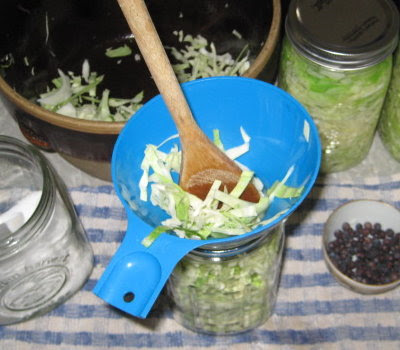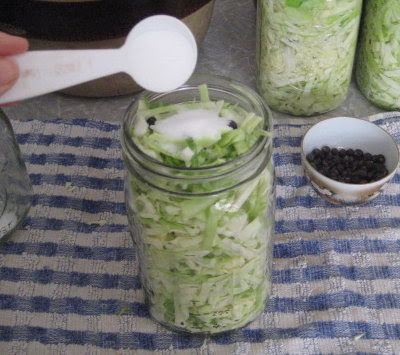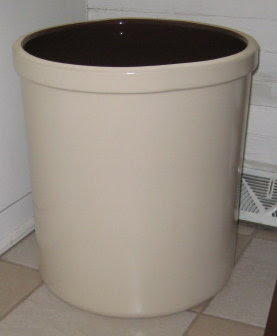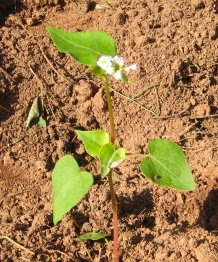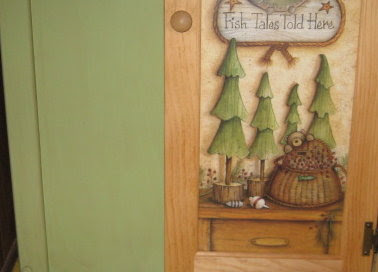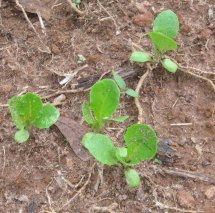 Our wild southern Appalachian roses produce hips that small and seedy, but sweet. I had read that the best time to gather them for jelly is after first frost. Evidently this softens them a bit. However, when I went out a few weeks ago to check on them, I discovered that not only were they beginning to turn red, but some of them had also gone out to dry out and turn black. I decided I'd better harvest not, first frost or no. This turned out to be a wise decision because our first frost didn't phase them a bit.
Our wild southern Appalachian roses produce hips that small and seedy, but sweet. I had read that the best time to gather them for jelly is after first frost. Evidently this softens them a bit. However, when I went out a few weeks ago to check on them, I discovered that not only were they beginning to turn red, but some of them had also gone out to dry out and turn black. I decided I'd better harvest not, first frost or no. This turned out to be a wise decision because our first frost didn't phase them a bit.Most of the recipes I found online call for two quarts (8 cups) of hips. It was time consuming collecting so many, so I did it over several days, choosing the ripest ones. Rose hips will ripen after picking, but I like to let things ripen on the plant. Eventually I got the amount called for.
 One thing that the recipes said that I didn't do, was to cut off all the blossom ends and stems. Good grief, I thought. Mine are so teeny and there must be a squillion of them. I figured these would strain out anyway, so most of them were left on.
One thing that the recipes said that I didn't do, was to cut off all the blossom ends and stems. Good grief, I thought. Mine are so teeny and there must be a squillion of them. I figured these would strain out anyway, so most of them were left on.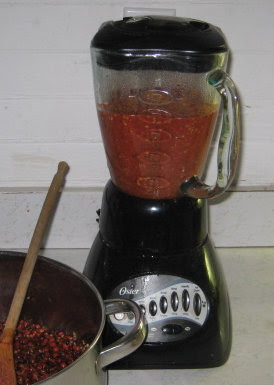 I simmered them for about 15 minutes in enough water to cover them. They are supposed to be mashed to release the pulp, these were too small for my potato masher. I decided to pop it all into my blender and give it a whirl.
I simmered them for about 15 minutes in enough water to cover them. They are supposed to be mashed to release the pulp, these were too small for my potato masher. I decided to pop it all into my blender and give it a whirl.Actually some of them were still a little hard, so I probably should have simmered them longer. One recipe called for simmering for an hour.
Even so, the blender pulverized the whole thing pretty well. The color at this point looked more like a tomato sauce red than rose hip red.
It was pretty late by this time so I put the pulp into my jelly bag and let it drip drain over night.
In the morning, I was pleased that I had gotten the required four cups of rose hip juice for the recipe, but dismayed that the color wasn't any better. In fact it was worse. Definitely not a color one would associate with roses...
 Why am I so concerned about the color? Because I've always been a "handmade for the holidays" person, though usually my gifts are sewn, embroidered, quilted, knitted, or handwoven. Due to all the work we've been doing on the homestead this year, I figured homemade jams and jellies would suit. Even so, I give to a few folks who consider me a health food nut. I could just imagine one of them opening this color jelly and thinking to themselves, "So. She's still at it with the bark and twigs, eh?"
Why am I so concerned about the color? Because I've always been a "handmade for the holidays" person, though usually my gifts are sewn, embroidered, quilted, knitted, or handwoven. Due to all the work we've been doing on the homestead this year, I figured homemade jams and jellies would suit. Even so, I give to a few folks who consider me a health food nut. I could just imagine one of them opening this color jelly and thinking to themselves, "So. She's still at it with the bark and twigs, eh?"Time for a true confession. This bothered me so much at first that I actually thought about cheating. For a brief second I contemplated adding red food coloring! Then I came to my senses.
I suspect it was those blossom ends and stems that affected the color. When I tasted the freshly squeezed juice, it was a bit bitter, which leads me to suspect that natural tannins may be the culprit. I was discouraged but I still pressed on, deciding to wait for the final product before declaring the whole thing a failure.
Yield?
 Six half-pints and enough for me to sample on an almond butter and rose hip jelly sandwich made with toasted homemade whole wheat bread...
Six half-pints and enough for me to sample on an almond butter and rose hip jelly sandwich made with toasted homemade whole wheat bread... Happily, it turned out to be quite tasty. And the color isn't too bad either, so yes, I'll use them for gifts. I plan to wrap them in little drawstring bags sewn from my handwoven remnants.
Happily, it turned out to be quite tasty. And the color isn't too bad either, so yes, I'll use them for gifts. I plan to wrap them in little drawstring bags sewn from my handwoven remnants.I have since learned the rugosa roses are the most popular varieties for rose hip production. I'll have to consider a spot for a bush or two and maybe my rose hip ventures will be a little easier in the future.
Rose Hip Jelly photos & text copyright October 2009



